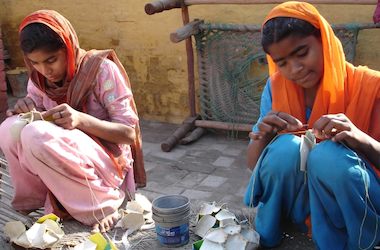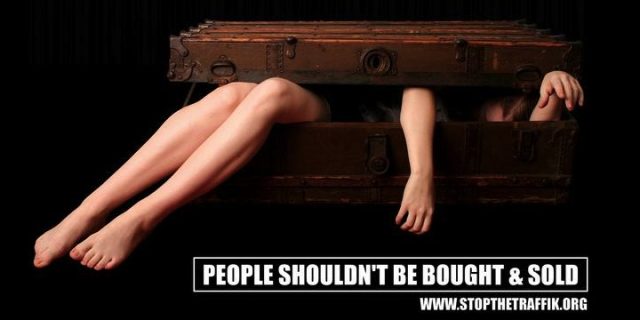This page in brief
People are being trafficked or tricked into slavery all around the world, to become slave labour, or forced into prostitution or fighting in armed conflicts. This leaves leaves millions of powerless people in misery.
There are many organisations working to strop this vile trade, and there are things we can do to help.
The extent of people trafficking
People trafficking is the coercive trade of human beings to provide cheap or free labour – effectively slavery. Because this is an illegal and mostly hidden activity, all estimates are very approximate. The best information I can find indicates:
- Somewhere between 3 and 6 million people are trafficked each year worldwide. About 1.2 million of these are children.
- Women and girls are the most vulnerable – 75-80% of victims are female.
- Trafficking has led to there currently being close to 30 million slaves worldwide.
- Latin America and the Caribbean accounts for almost half of trafficked children worldwide.
- Thailand and Brazil are the countries with the worst records for trafficking overall.
- Japan, USA, Australia and Western Europe are reported to be the top destinations for trafficking victims, presumably because these represent the best opportunities for making a profit, particularly from prostitution.
The purposes of trafficking
Trafficking is considered to be the third largest transnational criminal activity, after arms and drugs, and is estimated to be worth about $32bn a year in profits made from slave labour. The main purposes of trafficking are:
- About three quarters of all trafficking is coercing women and girls into prostitution, generally under slave conditions.
- Most of the rest are trafficked to provide forced labour, including begging. Some children are forced into working on cocoa plantations in West Africa.
- Other trafficking is for conscription into armed forces and the trade in body parts.
How it happens
Trafficking generally preys on vulnerable people who are poor and powerless.

- Some are kidnapped and simply disappear. Homeless children are particularly vulnerable.
- Some are forced into slavery by threats to them or their families.
- Others are tricked into travelling away from home thinking good work is awaiting them.
- Some poor families sell children into slavery to get much needed cash.
Trafficking victims generally end up in slavery, debt bondage or servitude, often for life. Abuse, threats and even torture are commonly used to force compliance.
In a recently publicised episode (reported in 2011), a 14 year old Moldovan girl was kidnapped and illegally trafficked into a series of countries across Europe to work in the sex trade. Once when she returned home to have a baby, she and her family were threatened and beaten and she was forced back into prostitution. Four years later, she ended up in Britain, where authorities discovered her and, believing she would be safe back home, deported her. However the traffickers found her again in Moldova, raped and tortured her terribly and trafficked her back to Britain, where she was again discovered and freed.
Combatting trafficking
A large range of actions are being pursued to reduce, and try to eliminate, human trafficking:
- The UN and various international conventions seek to strengthen laws and improve law enforcement in all countries.
- Organisations like Stop the Traffik, World Vision, Coalition to Abolish Slavery and Trafficking (CAST), Global Alliance Against Traffic in Women (GAATW) and UNICEF advocate to governments to increase anti-trafficking policing and surveillance and educate politicians and voters.
- Aid and welfare organisations conduct on-the-ground prevention by caring for poor and orphaned children, working with teachers, tourism operators and local governments to educate children about their rights, and to prevent trafficking directly.
- Some organisations also undertake child rescue, to remove children from slavery and place them in safe environments.
We can help
- Support overseas aid and advocacy organisations financially.
- Write to politicians supporting stronger laws and enforcement.
- Those who live in countries where people are at risk, and those who live in destination countries can be aware of the problem and recognise victims of trafficking.
- Choose to buy certified “traffic-free” products such as chocolate, tea and coffee, and some types of clothing.
Some of the references below give more ideas on responses.
Photos: Tirionelf and © Copyright World Vision Australia. All rights reserved. Used by permission.. When I first used the top graphic, it was on a site that I understood to allow free use of its graphics. I cannot now find that page, but the artist’s site has a download button, which I used. I have left a message seeking clarification of whether this graphic is still free to use. If I find it isn’t, I will remove it of course.
Feedback on this page
Comment on this topic or leave a note on the Guest book to let me know you’ve visited.
Further reading
- Wikipedia on Human trafficking and Trafficking of children.
- World Vision: Human trafficking and slavery.
- Stop the Traffik.
- The story of the Moldovan girl repeatedly abused and trafficked.
- United Nations: Global report on trafficking in persons.
- Trafficking of women: Global Alliance Against Traffic in Women and The Advocates for Human Rights.
- Combatting human trafficking: humantrafficking.org.
- 10 Things You Didn’t Know About Slavery, Human Trafficking (And What You Can Do About It). Huffington Post, 2014.
- World Bank: Human Trafficking: A Brief Overview (Dec 2009).
- Do something.org: 11 Facts About Human Trafficking
- Human Traffic Awareness Month 2016 – Huffington Post and The National Child Traumatic Stress Network




